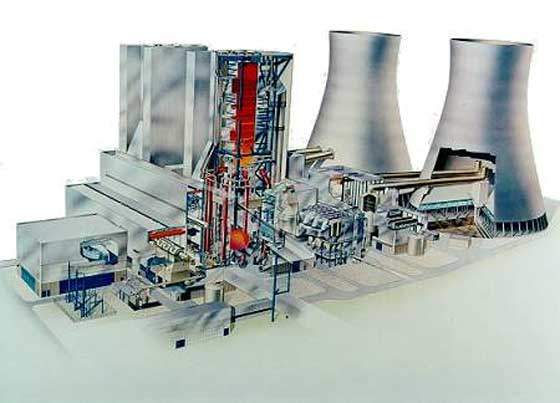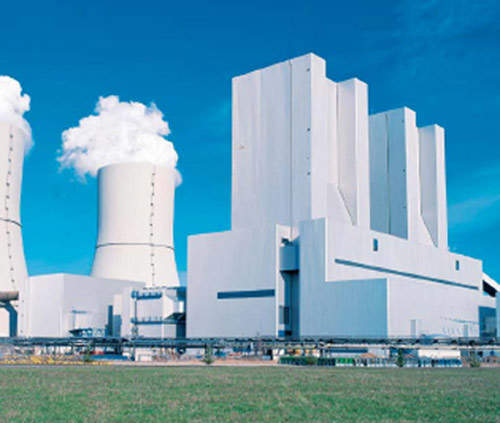The Lippendorf power plant in Germany has been modernized and slightly expanded, and is now producing 16,000MW of electrical power.
Veag Vereinigte Energiewerke AG (Veag) of Berlin put forward a plan to renew and modernise its power plant in 1993. At that time it had 15,000MW of power from its power stations, of which approximately 2,000MW was generated by water and 1,000MW by gas turbines.
Veag decided on the modernisation of 4,000MW worth of lignite power production and the piecemeal closure of the remaining 8,000MW. In its place it constructed 4,000MW of lignite-fuelled base-load production and 4,000MW of static load production, which would largely be fuelled by imported hard coal. The two blocks each have a capacity of 933MW with 43% fuel efficiency.
LIGNITE-BASED POWER PLANT
The Lippendorf power station, 15km south of Leipzig, was the second station in a new series in the lignite fields of the new German Lander. Employing new high-temperature technology and with a 42.4% design efficiency, the units set new standards for lignite-based power plants. The plant also has a district heating capability of 300MW. The plant was the biggest private building project in Saxony.
The new 933MW R and S units replaced the former Lippendorf and Thierback power plants. Lippendorf was built jointly by a group of German utility companies made up of Veag, Bayernwerk AG, Munich, Energieversorgung Schwaben AG, Stuttgart, and Badenwerk AG, Karlsruhe. Veag takes power from unit R, while unit S supplies southern German utilities Bayernwerk, Badenwerk and EVS.
Conceptual engineering for Lippendorf began in August 1993. MAN Energie GmbH (ME) of Nuremberg, a subsidiary of GEC Alsthom, won the largest planning contract in its history. Energie-und Umwelttechnik GmbH (EUT) of Radebeul was also involved at the planning stage of the project. Design engineering of the plant began in November 1994 followed by on-site construction in October 1995. After synchronisation at the end of June 1999, the trial run for unit S began late in 1999. The lignite-fired power plant went into production in June 2000. An estimated 5,000 jobs were created in the region.
LIPPENDORF PLANT MAKE-UP
Overall engineering of both power station units was handled by GEC Alsthom Energie GmbH in co-operation with EUT, Dresden-Radebeul.
Babcock Lentjes Kraftwekstechnik (BLK) GmbH, part of the Deutsche Babcock Group, designed the steam generators and was the sole contractor for the steam process, coal-firing system and much of the auxiliary equipment. This included the mills, the ignition and back-up firing equipment, the forced-draught and induced-draught fans, the high-pressure bypass stations, reheat safety valves and the refractory lining.
STEAM GENERATORS
Each of the two base-load power plant units consists of a lignite fire Benson steam generator. They operate at supercritical steam conditions (554°C) and a high reheat temperature (583°C). These were at the time the highest values for lignite fired steam generators.
The pressure drop in the system was reduced to a very low value for the size of plant. A special plastic heat exchanger provides maximum heat recovery between the ESP and FGD without suffering from corrosion. The water from two flue-gas coolers supplies one condensate preheater.
Special firing measures will ensure low emissions of nitrous oxides. The flue gases for each unit are each passed through two parallel flue gas ducts equipped with an electrostatic precipitator and a desulphurisation system. As a result, over 99% of dust and more than 95% of sulphur dioxide is filtered out.
Environmental protection systems reduced emissions and contribute to the continuing quality of the energy supply system. The power station produces 97% less dust and nearly 96% lower sulphur oxide emissions than those in Thierbach and Lippendorf that it is replacing.
CONTRACTS
ABB won the turbine and generator supply contract for Lippendorf. The ABB contract covered the manufacture and erection of both steam turbosets, two 30MW feedwater pump turbines, the generator plants consisting of three-phase synchronous turbo-generator, exciter system equipped with stationary thyristors and generator auxiliary equipment for hydrogen, sealing oil and water purification. ABB increased output power from their turbines as a result of the use of new materials for the high temperature range of 600°C / 300bar.
This contract marked a breakthrough for ABB in eastern Germany, which had been dominated by Siemens. However, its win was challenged in the courts by GE, which claimed to have submitted a better bid. The dispute was finally resolved with an agreement between Veag and GE to co-operate on a joint investigation as to how GE technology may be used to meet Veag’s future plant requirements.
Other companies participating in the Lippendorf project were Lahmeyer International (consultants), Austrian group VA Technolgie (electrical equipment), Hamon Thermal Engineers and Contractors (natural-draught cooling towers), Gea Waerme-und Umwelttechnik GmbH (heat recovery plant) and Balcke Durr (condensate preheater). Siemens Teleperm XP was chosen for the plant control system.
FUEL SUPPLY
The fuel for running the plant is guaranteed by long-term supply contracts concluded with central German lignite producers Vereinigte Mitteldeutsche Braunkohlenwerke AG (MIBRAG). Heuersdorf, a village of 320 people, has been relocated, as it was on the proposed site for the opencast brown coal mine that was to supply the new power station.
Lignite is central to Veag’s fuel policy. More than 60% of German’s energy supply depends on imports, and lignite is the only domestic fuel available to meet the country’s long-term energy needs. Lignite production secures thousands of jobs.









